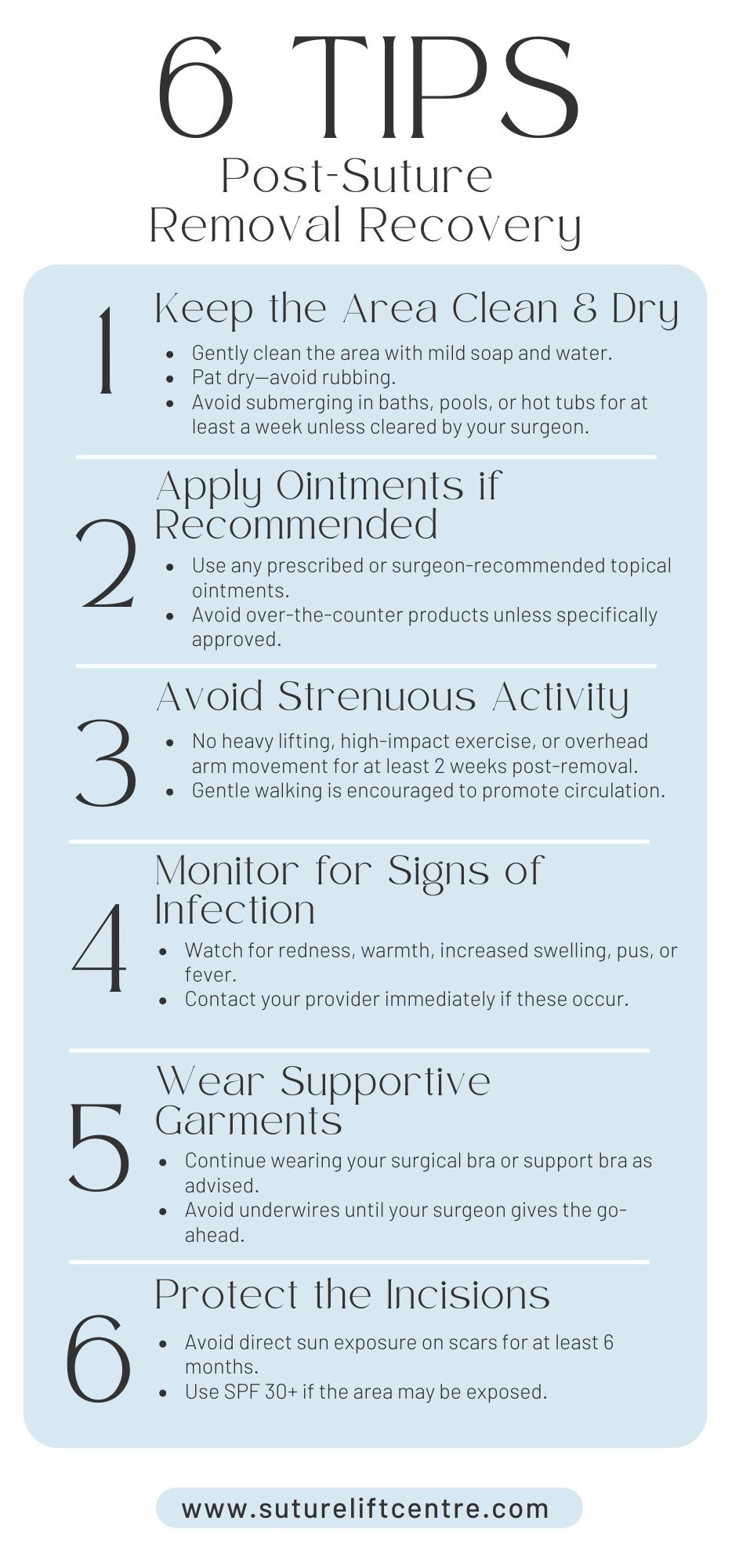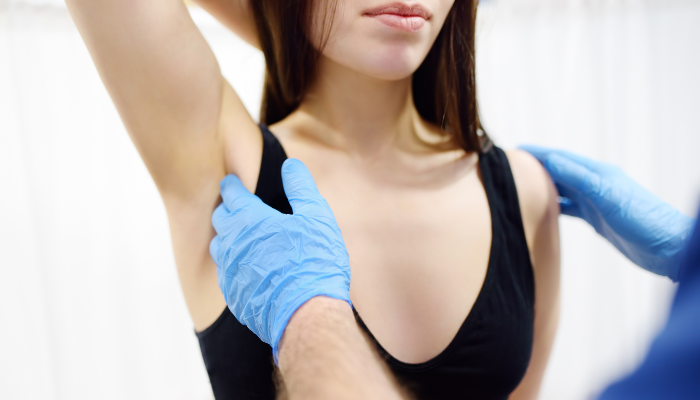A breast lift can be a confidence-boosting experience—but what comes after the surgery often feels like uncharted territory. One of the most common questions, what happens during recovery after a suture lift?
It might sound minor, but suture removal plays a key role in how you heal and how your results turn out. In this post, we’ll clear up what to expect, share simple aftercare tips, and reveal a few things that might just surprise you about the process. Keep reading—you’re closer to feeling fully at ease with recovery than you think.
Key Takeaways
- Suture removal is a professional procedure, crucial for optimal healing.
- Follow your surgeon’s specific post-removal care instructions.
- Keep an eye out for any signs of complications during recovery.
- Hydration and proper skincare are key to maintaining results.
- Regular follow-ups with your surgeon help ensure long-term satisfaction.
Understanding The Breast Lift Suture Removal Process

What To Expect During The Procedure
So, the big day is approaching – suture removal. It’s normal to feel a bit anxious, but honestly, it’s usually a pretty straightforward process. Generally, the appointment is quick, and the actual removal is often less uncomfortable than you might imagine.
Your surgeon or a trained nurse will carefully snip and pull out each suture. You might feel a slight tugging or pulling sensation, but it shouldn’t be painful. If you’re worried about discomfort, have a chat with your surgeon beforehand; they might suggest taking a mild painkiller beforehand.
Importance Of Professional Removal
I know it might be tempting to try and remove the sutures yourself – just don’t! It’s really important to have a professional do it. Here’s why:
- Sterility: They use sterile equipment, reducing the risk of infection.
- Technique: They know the right way to remove sutures to avoid damaging the skin.
- Assessment: They can check the incision site for any signs of complications.
Trying to DIY suture removal can lead to infections, scarring, or even reopening of the incision. It’s just not worth the risk. Leave it to the experts!
Post-Removal Care Guidelines
As your body adjusts to the internal threads, it’s all about keeping the area clean and promoting healing. Here’s what you should do:
- Keep it clean: Gently wash the area with mild soap and water.
- Pat it dry: Avoid rubbing; pat the area dry with a clean towel.
- Apply ointment: Your surgeon might recommend an antibiotic ointment or scar cream. Follow their instructions.
- Wear a supportive bra: This will help to minimise movement and support the breasts as they heal.
It’s also a good idea to avoid any strenuous activity or heavy lifting for a few days after suture removal. Listen to your body and take it easy.
Preparing For Your Suture Removal Appointment
After your permanent suture lift, the recovery is generally quick, with minimal downtime. Still, how you care for the area in the first few days can impact comfort and results. Think of it as the final stretch in your breast lift journey – almost there!
Consultation With Your Surgeon
Before the actual removal, you’ll have a consultation with your surgeon. This is really important. It’s your chance to ask any last-minute questions or voice any concerns you might have.
- Discuss the healing progress.
- Confirm the removal plan.
- Address any discomfort you’re experiencing.
Your surgeon will assess the area, check for any signs of infection, and explain exactly what to expect during the removal.
Pre-Appointment Instructions
Following your surgeon’s pre-appointment instructions is key. These instructions are designed to minimise any risks and make the removal process easier. Typically, you’ll be advised to:
- Avoid applying lotions or creams to the area.
- Wear loose, comfortable clothing.
- Ensure the area is clean.
Stick to these guidelines to avoid any complications. It might also be a good idea to avoid taking any blood-thinning medications, like aspirin, unless specifically approved by your surgeon.
What To Bring On The Day
On the day of your appointment, it’s a good idea to bring a few things to make yourself more comfortable. Here’s a quick checklist:
- Your identification and insurance details.
- A list of questions for your surgeon.
- A supportive bra to wear after the removal.
Bringing a friend or family member can also be a good idea, especially if you’re feeling a bit anxious. Having someone there for support can make the whole experience much easier. Plus, they can help you remember any post-removal instructions your surgeon gives you.

Post-Removal Recovery Tips
Alright, so the sutures are out – fantastic! But the journey doesn’t end there. It’s now time to focus on proper aftercare to ensure the best possible outcome.
Let’s dive into some essential tips to help you through this phase.
Managing Discomfort After Removal
You might feel a bit tender after the sutures are removed. It’s totally normal. The key is to manage any discomfort proactively. Over-the-counter pain relief, like paracetamol or ibuprofen, usually does the trick. Just stick to the recommended dosage.
Also, a cold compress can work wonders to reduce swelling and numb the area a bit. Just wrap some ice in a towel and apply it gently for about 15-20 minutes at a time, several times a day. Avoid putting ice directly on your skin, though – that’s a no-no.
Signs Of Complications To Watch For
While most suture removals go smoothly, it’s always good to be aware of potential complications. Keep an eye out for these things:
- Increased redness or swelling around the incision sites.
- Pus or any discharge coming from the area.
- A fever – anything above 38°C (100.4°F).
- Worsening pain that isn’t relieved by medication.
- Noticeable separation of the incision edges.
If you notice any of these, get in touch with your surgeon ASAP. It’s always better to be safe than sorry, and they’ll be able to advise you on the best course of action.
When To Resume Normal Activities
This is the question everyone wants answered, right? Well, it depends a bit on how quickly you heal and the type of activities you’re planning. Generally, you can resume light activities within a few days after suture removal. But hold off on anything strenuous, like heavy lifting or intense exercise, for at least a couple of weeks.
Listen to your body – if something feels uncomfortable, stop! And always follow your surgeon’s specific instructions, as they know your situation best.
Remember, patience is key during this recovery period. Don’t rush things, and give your body the time it needs to heal properly. By following these tips and staying in touch with your surgeon, you’ll be well on your way to enjoying the full benefits of your breast lift.
Caring For Your Skin After Suture Removal
Recommended Skincare Products
Alright, so the sutures are out, and now it’s all about giving your skin some TLC. Think gentle. Harsh chemicals are a no-go. Opt for fragrance-free and hypoallergenic products to minimise any irritation.
Hydration And Moisturisation Tips
Hydration, both inside and out, is key. Drink plenty of water. For moisturising, go for something rich but non-comedogenic (won’t block pores). Apply it while your skin is still slightly damp after showering to lock in that moisture.
Avoiding Sun Exposure
Sun’s out, skin’s… covered! This is super important. Your skin will be extra sensitive after suture removal, so sun exposure is a big no-no.
Honestly, even on cloudy days, UV rays can still do damage. So, slap on a broad-spectrum sunscreen with at least SPF 30 every single day. And don’t forget a hat and sunglasses for extra protection. Your future self will thank you for it.
Here’s a quick checklist:
- Apply sunscreen daily (SPF 30 or higher).
- Wear a wide-brimmed hat when outdoors.
- Seek shade during peak sun hours (10 am – 4 pm).
Long-Term Care For Your Breast Lift Results
It’s easy to think that once the sutures are out, the hard work is over. But to really make the most of your breast lift and enjoy the results for years to come, a bit of long-term care is key.
Maintaining Skin Elasticity
Elasticity is what keeps your skin looking firm and youthful. To help maintain it after your breast lift, consider these points:
- Stay hydrated: Drinking plenty of water helps keep your skin supple.
- Use quality skincare: Products with ingredients like retinol or peptides can boost collagen production.
- Consider non-surgical treatments: Things like radiofrequency or ultrasound can help stimulate collagen and elastin.
Regular Follow-Up Appointments
Don’t skip those follow-up appointments with your surgeon! They’re not just a formality. They’re a chance to:
- Monitor your healing progress.
- Address any concerns you might have.
- Get personalised advice on long-term care.
Lifestyle Changes For Optimal Results
Your lifestyle plays a big role in how well your breast lift results hold up.
Here are a few things to keep in mind:
- Maintain a stable weight: Significant weight fluctuations can affect the shape and appearance of your breasts.
- Wear supportive bras: Especially during exercise, a good sports bra is essential.
- Avoid smoking: Smoking damages collagen and elastin, which can lead to premature sagging.
It’s worth remembering that while a breast lift can provide a significant and lasting improvement, it doesn’t stop the natural ageing process. By adopting a proactive approach to long-term care, you can help maintain your results and enjoy your new shape for as long as possible.
Common Concerns And Questions
Addressing Anxiety About The Procedure
It’s completely normal to feel a bit anxious before getting your sutures removed. The key thing to remember is that suture removal is usually a quick and straightforward process. Talk to your surgeon about your worries; they can explain exactly what will happen and reassure you.
Sometimes, just knowing what to expect can make a huge difference. Maybe try some relaxation techniques beforehand, like deep breathing or listening to calming music. It’s all about finding what helps you feel more at ease.
Understanding Healing Times
Okay, so everyone heals at their own pace, and that’s just a fact. There’s no one-size-fits-all answer to how long it’ll take for your skin to fully recover after suture removal. Factors like your age, overall health, and how well you followed post-op instructions all play a part.
Generally, you can expect some redness or slight swelling for a few days, but this should gradually subside. If you’re concerned about your healing progress, don’t hesitate to reach out to your surgeon. They can assess your situation and give you personalised advice.
The Role Of Your Surgeon In Recovery
Importance Of Follow-Up Visits
Follow-up appointments are super important. They’re not just a formality; they’re a chance for your surgeon to check how you’re healing, spot any potential problems early on, and make sure everything’s going according to plan.
Plus, it’s a great time to ask any questions that have popped up since your last visit. Don’t skip these appointments – they’re a key part of getting the best possible result from your breast lift.
How Your Surgeon Can Assist
Your surgeon’s role extends far beyond the operating theatre. They’re there to provide support and guidance throughout your recovery. This might include:
- Managing any discomfort with appropriate pain relief.
- Offering advice on wound care to minimise scarring.
- Addressing any concerns you have about your healing progress.
- Providing reassurance and emotional support.
It’s easy to feel a bit anxious or uncertain during recovery, but remember, your surgeon is an expert in this area. They’ve seen it all before and can offer tailored advice to help you through any challenges.
Conclusion
Suture removal might seem like a small detail in your breast lift journey, but it plays a big role in your healing, comfort, and final results. Understanding what to expect—and how to care for yourself afterward—can make all the difference in both your confidence and your recovery.
If you’re preparing for this step or still weighing your options, use what you’ve learned here to ask informed questions, seek expert guidance, and make choices that truly support your body’s healing. The more you know, the more empowered you’ll feel—because recovery isn’t just about following instructions, it’s about taking charge of your well-being.
Frequently Asked Questions
What happens during the suture removal process?
During the suture removal, your surgeon will carefully take out the stitches used in your breast lift. This is usually quick and should not cause much discomfort.
Is it necessary to have a professional do the suture removal?
Yes, it is important to have a trained professional remove the sutures to ensure that it is done safely and correctly, avoiding any complications.
How should I care for my skin after the sutures are removed?
After removal, keep the area clean and moisturised. Avoid harsh products and sun exposure for the best healing.
What signs should I look for that might indicate a problem?
Watch for redness, swelling, or unusual pain in the area. If you notice any of these, contact your surgeon right away.
When can I go back to my normal activities after suture removal?
You can usually return to your normal activities within a few days, but it’s best to follow your surgeon’s advice for your specific situation.
How can I maintain the results of my breast lift long-term?
To keep your results looking good, stay hydrated, use good skincare products, and make regular follow-up appointments with your surgeon.




